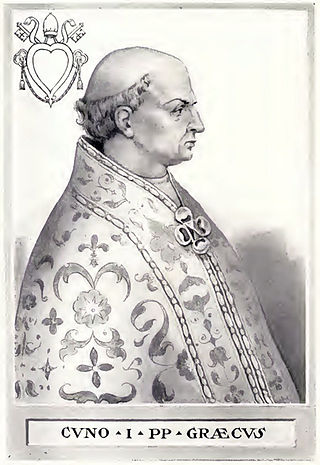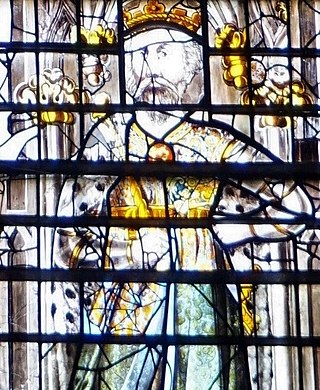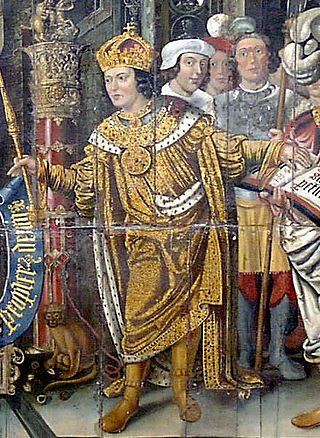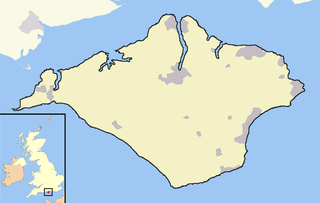Arwald [lower-alpha 1] (died 686 AD) was the last King of the Isle of Wight and last pagan king in Anglo-Saxon England. [2]
Contents

Arwald [lower-alpha 1] (died 686 AD) was the last King of the Isle of Wight and last pagan king in Anglo-Saxon England. [2]

Nearly all that is known of him is from Bede's Historia ecclesiastica gentis Anglorum , which describes the invasion of the Isle of Wight by Cædwalla, King of Wessex.
It is unclear what Arwald's heritage was, but it is speculated that he was Jutish and was a local Island warlord.
Arwald was killed in battle, but his two sons escaped to the Great Ytene Forest (now called the New Forest). [3] They were betrayed to Cædwalla and taken to a place where he "was in hiding with his wounds" at Stoneham, near Southampton. Shortly before they were put to the sword they allegedly converted to Christianity by the intervention of Abbot Cynibert of Hreutford, [4] being described by Bede as "the first fruits" of the massacre because of this conversion. Cædwalla later died of wounds sustained during his invasion.
Though venerated as saints, their names are unknown, but they are called collectively "St. Arwald" after their father. Their feast day is 22 April. [5]
Arwald's unnamed sister survived, as the wife of the king of Kent. She is a direct ancestor of Alfred the Great[ citation needed ].
An annual gathering happens on the evening of the first Monday after the 22nd of April at Sandown Library on the Isle of Wight to commemorate the anniversary of death of Arwald. The evening consists of poetry, dramatic readings and music and is often streamed live to people all around the world.
In 2020 a community of Isle of Wight druids held a ceremony at the Longstone near Brighstone. This was done as a podcast. [6]
The Quay Arts Centre in Newport exhibited an Isle of Wight Hidden Heroes exhibition which included a sculpture of a mask of Arwald by Nigel George. This is now on permanent display at Newport Roman Villa. [7]
Caedwalla by Frank Cowper (1888) portrays Arwald as the pagan antagonist to the Christian Caedwalla. [8] A similar juxtaposition, but from a pagan viewpoint, is employed by Jan Harper Whale's Wihtwara Trilogy. [9]
Arwald's Kingdom; Tales from the Isle of Wight (2018) by Mark Francis is a book of poetry, stories and hiking around the Isle of Wight. [10]
Æthelberht was King of Kent from about 589 until his death. The eighth-century monk Bede, in his Ecclesiastical History of the English People, lists him as the third king to hold imperium over other Anglo-Saxon kingdoms. In the late ninth century Anglo-Saxon Chronicle, he is referred to as a bretwalda, or "Britain-ruler". He was the first English king to convert to Christianity.

The Jutes were one of the Germanic tribes who settled in Great Britain after the departure of the Romans. According to Bede, they were one of the three most powerful Germanic nations, along with the Angles and the Saxons:
Those who came over were of the three most powerful nations of Germany—Saxons, Angles, and Jutes. From the Jutes are descended the people of Kent, and of the Isle of Wight, and those also in the province of the West Saxons who are to this day called Jutes, seated opposite to the Isle of Wight.

The Kingdom of Wessex was an Anglo-Saxon kingdom in the south of Great Britain, from 519 until England was unified by Æthelstan in 927.
The 680s decade ran from January 1, 680, to December 31, 689.

Year 686 (DCLXXXVI) was a common year starting on Monday of the Julian calendar. The denomination 686 for this year has been used since the early medieval period, when the Anno Domini calendar era became the prevalent method in Europe for naming years.

The Kingdom of the South Saxons, today referred to as the Kingdom of Sussex, was one of the seven traditional kingdoms of the Heptarchy of Anglo-Saxon England. On the south coast of the island of Great Britain, it was originally a sixth-century Saxon colony and later an independent kingdom. The kingdom remains one of the least known of the Anglo-Saxon polities, with no surviving king-list, several local rulers and less centralisation than other Anglo-Saxon kingdoms. The South Saxons were ruled by the kings of Sussex until the country was annexed by Wessex, probably in 827, in the aftermath of the Battle of Ellendun.
Wilfrid was an English bishop and saint. Born a Northumbrian noble, he entered religious life as a teenager and studied at Lindisfarne, at Canterbury, in Francia, and at Rome; he returned to Northumbria in about 660, and became the abbot of a newly founded monastery at Ripon. In 664 Wilfrid acted as spokesman for the Roman position at the Synod of Whitby, and became famous for his speech advocating that the Roman method for calculating the date of Easter should be adopted. His success prompted the king's son, Alhfrith, to appoint him Bishop of Northumbria. Wilfrid chose to be consecrated in Gaul because of the lack of what he considered to be validly consecrated bishops in England at that time. During Wilfrid's absence Alhfrith seems to have led an unsuccessful revolt against his father, Oswiu, leaving a question mark over Wilfrid's appointment as bishop. Before Wilfrid's return Oswiu had appointed Ceadda in his place, resulting in Wilfrid's retirement to Ripon for a few years following his arrival back in Northumbria.

Wulfhere or Wulfar was King of Mercia from 658 until 675 AD. He was the first Christian king of all of Mercia, though it is not known when or how he converted from Anglo-Saxon paganism. His accession marked the end of Oswiu of Northumbria's overlordship of southern England, and Wulfhere extended his influence over much of that region. His campaigns against the West Saxons led to Mercian control of much of the Thames valley. He conquered the Isle of Wight and the Meon valley and gave them to King Æthelwealh of the South Saxons. He also had influence in Surrey, Essex, and Kent. He married Eormenhild, the daughter of King Eorcenberht of Kent.

Ine, also rendered Ini or Ina, was King of Wessex from 689 to 726. At Ine's accession, his kingdom dominated much of southern England. However, he was unable to retain the territorial gains of his predecessor, Cædwalla, who had expanded West Saxon territory substantially. By the end of Ine's reign, the kingdoms of Kent, Sussex, and Essex were no longer under West Saxon sway; however, Ine maintained control of what is now Hampshire, and consolidated and extended Wessex's territory in the western peninsula.

Cædwalla was the King of Wessex from approximately 685 until he abdicated in 688. His name is derived from the Welsh Cadwallon. He was exiled from Wessex as a youth and during this period gathered forces and attacked the South Saxons, killing their king, Æthelwealh, in what is now Sussex. Cædwalla was unable to hold the South Saxon territory, however, and was driven out by Æthelwealh's ealdormen. In either 685 or 686, he became King of Wessex. He may have been involved in suppressing rival dynasties at this time, as an early source records that Wessex was ruled by underkings until Cædwalla.
Wihtred was king of Kent from about 690 or 691 until his death. He was a son of Ecgberht I and a brother of Eadric. Wihtred ascended to the throne after a confused period in the 680s, which included a brief conquest of Kent by Cædwalla of Wessex, and subsequent dynastic conflicts. His immediate predecessor was Oswine, who was probably descended from Eadbald, though not through the same line as Wihtred. Shortly after the start of his reign, Wihtred issued a code of laws—the Law of Wihtred—that has been preserved in a manuscript known as the Textus Roffensis. The laws pay a great deal of attention to the rights of the Church, including punishment for irregular marriages and for pagan worship. Wihtred's long reign had few incidents recorded in the annals of the day. He was succeeded in 725 by his sons, Æthelberht II, Eadberht I, and Alric.
Cenwalh, also Cenwealh or Coenwalh, was King of Wessex from c. 642 to c. 645 and from c. 648 until his death, according to the Anglo-Saxon Chronicle, in c. 672.

The Isle of Wight is rich in historical and archaeological sites, from prehistoric fossil beds with dinosaur remains, to dwellings and artefacts dating back to the Bronze Age, Iron Age, and Roman periods.
Centwine was King of Wessex from c. 676 to 685 or 686, although he was perhaps not the only king of the West Saxons at the time.

Anglo-Saxon England or Early Medieval England, existing from the 5th to the 11th centuries from soon after the end of Roman Britain until the Norman conquest in 1066, consisted of various Anglo-Saxon kingdoms until 927, when it was united as the Kingdom of England by King Æthelstan. It became part of the short-lived North Sea Empire of Cnut the Great, a personal union between England, Denmark and Norway in the 11th century.

Æthelwealh was ruler of the ancient South Saxon kingdom from before 674 till his death between 680 and 685. He was baptised in Mercia, becoming the first Christian king of Sussex. He was killed by a West Saxon prince, Cædwalla, who eventually became king of Wessex.

Wihtwara was the kingdom founded on the Isle of Wight, a 147-square-mile (380 km2) island off the south coast of England, during the Anglo-Saxon settlement of Britain. The name was derived from the Jutish name Wihtwara. Its capital was a fort named Wihtwarasburgh. It has been suggested that the modern-day village of Carisbrooke was built on top of Wihtwarasburgh due to the fact that they share their location. It has also been suggested that Wihtwarasburgh was built on top of a pre-existing Roman fort, but this has not been proven.

Eaglehead and Bloodstone Copses is a 10.3-hectare (25-acre) Site of Special Scientific Interest which is south of Ashey on the Isle of Wight. The site was notified in 1987 for its biological value.
The Meonwara were one of the tribes of Anglo-Saxon Britain. Their territory was a folkland located in the valley of the River Meon in Hampshire that was subsumed by the Kingdom of Wessex in the late seventh century.
The Christianisation of Anglo-Saxon England was a process spanning the 7th century. It was essentially the result of the Gregorian mission of 597, which was joined by the efforts of the Hiberno-Scottish mission from the 630s. From the 8th century, the Anglo-Saxon mission was, in turn, instrumental in the conversion of the population of the Frankish Empire.